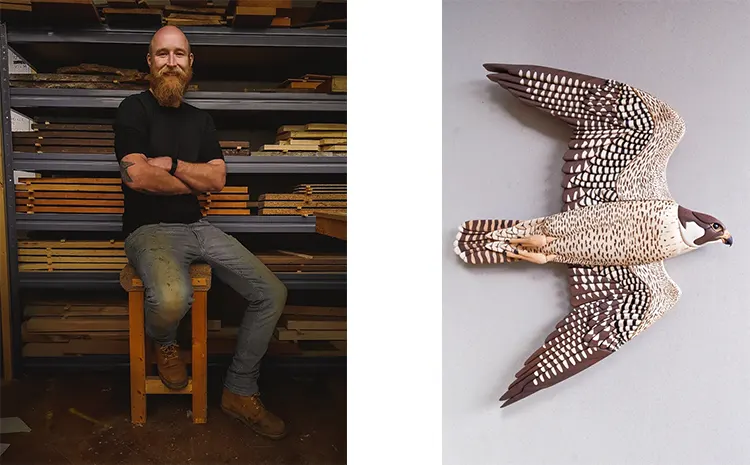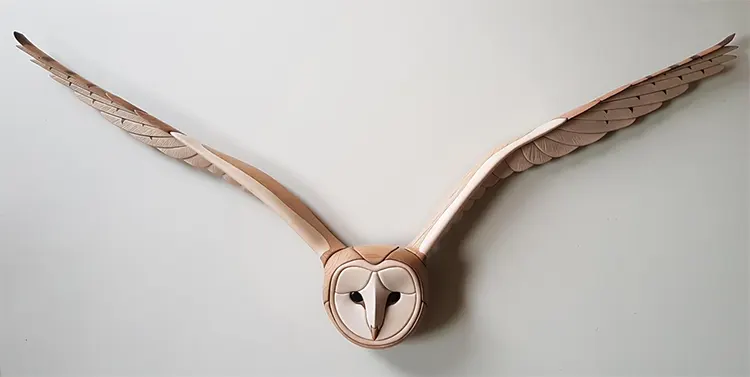“I combined my love of birds with my love of woodworking to create the artworks that I make now.”
A Woodworking Affinity
T.A.G. Smith is a UK-based wildlife artist known for his craftsmanship in creating intricate avian representations from wood. He skillfully captures the striking diversity and inherent beauty of bird species worldwide. The allure of the natural world, particularly the vast variation in avian species, sparks his creativity, and wood serves as an ideal canvas for Smith to reinterpret these creatures in his unique artistic style.
Smith employs a traditional method known as ‘intarsia’, akin to marquetry, which involves utilizing differently hued timbers to construct an image. Unlike marquetry, intarsia incorporates thicker pieces of wood, allowing them to be carved for a more tactile, three-dimensional effect. By elevating and recessing distinct sections, Smith lends a depth of perspective to his sculptures that enlivens his subject matter. Every element of the sculptures is meticulously hand-cut, carved, sanded, and polished. The individual pieces, reminiscent of jigsaw puzzle components, are then assembled and firmly bonded. Smith capitalizes on the natural hues of various timbers and, in his recent ventures, has begun to experiment with staining techniques to extend his color palette.
Smith’s journey into the art world commenced at the age of 21, following his departure from a university where he was pursuing a degree in Forensic Science. Despite his enduring fascination with the sciences – a subject he greatly admired in his school years – Smith came to realize that a career in this field did not align with his true calling. Upon leaving academia, Smith immersed himself in his woodworking hobby, finding solace and a renewed sense of purpose.
The positive reception to his creations and growing demand sparked the idea of turning his hobby into a full-fledged career. Birds, having always been a source of immense inspiration for Smith, became the focal point of his work. By fusing his admiration for avian life with his woodworking passion, Smith has crafted an artistic niche, producing artworks that capture the breathtaking complexity and beauty of the avian world.

T.A.G. Smith: Emulating Life in Wooden Sculptures
T.A.G. Smith’s artistic journey is a distinctive one, initiated not from a traditional artistic background, but rather from a deep-rooted affinity for woodworking. He began his creative exploration through a tangible relationship with wood, nurturing a symbiotic interaction that allowed both the material and the artist to thrive.
Over the course of his career, Smith ventured into various other artistic media, including acrylic painting and woodcut prints. These experiments held an element of joy for the artist, sparking new ideas through innovative techniques. He expressed a desire to revisit these mediums, indicative of an ongoing pursuit of diversification and exploration within his artistic repertoire.
In the creation of his avian representations, Smith displays a remarkable ability to echo the natural form and hues of his subjects. He adeptly employs fluid lines to delineate distinct areas of color and texture, creating a sense of movement and life in his wooden sculptures. Perhaps most intriguingly, Smith masterfully utilizes the grain direction of the wood to mirror the intricate flow of bird feathers, skillfully emulating their distinctive characteristics across the body, wings, and head. This technique not only demonstrates his keen attention to detail but also amplifies the realism and authenticity in each piece he creates.

Navigating Artistic Inspiration
In the vast landscape of artistic inspiration, T.A.G. Smith navigates with a unique compass, largely resisting the magnetic pull of other artists’ oeuvres. Although bewitched by the works of a select few, such as Tach Pollard, Carne Griffiths, and Jim Moir, he consciously distills his personal admiration for their creations from the wellspring of his artistic stimulation.
Smith, whose body of work is vast and diverse, cherishes a particular piece – the ‘Eleonora’s Falcon’, crafted in 2021. This sculpture, a magnum opus in his oeuvre, stands as his most substantial commission thus far. Spanning a meticulous three-month creation period, this masterwork is an intricate assembly of over 400 individual wooden pieces, each meticulously aligned to achieve a flawless fit.
As Smith’s most esteemed creation, the ‘Eleonora’s Falcon’ carries an unparalleled sense of accomplishment. His pride was further magnified when the opportunity to personally deliver the piece to a UK-based patron was presented. The privilege of witnessing the patron’s first reaction – one of pure elation – imprinted a memorable stamp of approval on this monumental work. Therefore, he regards this event as an affirming testament to the quality and impact of his artistry.

T.A.G. Smith: The Tools Behind the Masterpieces
In the personal atelier of T.A.G. Smith, a multitude of instruments facilitate the birth of his intricate works of art. The most crucial among these are his scrollsaw, rotary carving tool, and carving chisels. Smith skillfully employs his scrollsaw for meticulously carving out the wooden pieces that eventually take form as his signature bird sculptures. The rotary carving tool and chisels, on the other hand, aid in realizing his detailed carvings. Alongside these specialized tools, Smith’s workspace houses an array of traditional woodworking tools and machinery, such as table saws, bandsaws, drills, and sanders, each playing their part in his creative process.
Given the artist’s intense focus on his work, distractions are often a challenge. Smith’s artistic methodology unfolds in bursts of vigorous activity, with periods of intense productivity and creation. However, these are punctuated by intermittent intervals of procrastination and distraction, underlining the volatile nature of the creative process.
Smith’s mind teems with artistic visions and potential projects, akin to a vast array of other artists. Transforming these conceptual ideas into tangible realities poses its own set of challenges, with time being the most formidable adversary. The struggle of manifesting these cerebral imaginings is a quintessential part of the artist’s journey, weaving a complex tapestry of creative ambition and practical constraints.






